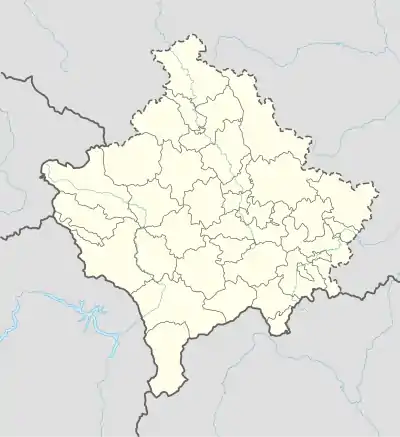Poljance
Polac or (Serbian Cyrillic: Пољанце; sometimes transliterated as Poljance) is a village in Kosovo.[lower-alpha 1] The village is exclusively inhabited by ethnic Albanians; in the 2011 census, it had 2701 inhabitants.
Polac
| |
|---|---|
Village | |
 Polac Location in Kosovo | |
| Coordinates: 42°44′16″N 20°49′24″E | |
| Location | |
| District | Mitrovicë |
| Municipality | Skënderaj |
| First mention | 1330 |
| Area | |
| • Total | 84.7 sq mi (219.5 km2) |
| Elevation | 2,100 ft (640 m) |
| Population (2011)[1] | |
| • Total | 2,701 |
| Time zone | UTC+1 (CET) |
| • Summer (DST) | UTC+2 (CEST) |
| Area code(s) | +381 290 |
Geography
It lies in the Drenica region, at the source of the Vrbica river, a left confluence of the Drenica river.[2] It lies on both sides of the regional Skenderaj-Glogavac road, 4–7 km southeast of Skenderaj.[2] It is 640–680 m over sea level.[2] The rural settlement lies on a cadastral area with the a total of 2195 hectares (K.O. Staro Poljance 694, K.O. Novo Poljance 767, K.O. Kraljica 734 ha).[2]
Poljance includes two major physiognomic parts: Staro Poljance (Džamijska, Gruda, Koca, Veljić and Zonić Mahala) and Novo Poljance, of which the latter was administratively joined into the present settlement in 1975.[2] Novo Poljance was an independent village before, situated to the east, established after World War I, with Serb and Montenegrin settlers from the vicinity of Danilovgrad, Nikšić, Mrkonjić Grad, Bosanska Krupa, among others.[2]
History
Middle Ages
The 1330 Dečani chrysobulls of Serbian King Stephen Uroš III (r. 1322–1331) mention the great village of "Strelac", and several surrounding villages: Čigotovo (Čikatovo), Vrbovec, Poljance, Glabotino and Kudrino (Kudrin).[3][4] Toponomastic study shows that Poljance bordered Strelac on the northeast.[4] There exist an old and newer Serbian cemetery in the village.[5]
World War II
The partisan guard in Novo Poljance, composed exclusively of Albanians, was captured due to treason, on January 30, 1945. At this time, there were a minor part of ethnic Albanian Partisans that crossed to the nationalist Balli Kombëtar, and killed Serbs in their units. A court was held and Šaban Poluža and Mehmed Gradica were sentenced to death. They were never executed as Osman Zonić took them to refuge during fighting, and hid them in a room were women stayed.[6]
6 soldiers, hailing from Poljance, of the "Boro Bukmirović" and "Razim Sadiku" battalions of the First Macedonian-Kosovan National liberation Brigade (Yugoslav Partisans) fell in January and February 1945.[7]
Kosovo War
According to the Serbian newspaper Pravda in January in February 1997, Jonuz Veliqi, an Albanian official working for the state structures of the Republic of Serbia, was nearly killed by during attacks of the Albanian paramilitaries.[8] On August 3, 1998, a civilian worker for the Serbian Interior Ministry was wounded by an automatic weapon.[9] Poljance was in the hands of the Kosovo Liberation Army until March 22, 1999, when Serbian police forces launched an offensive into Drenica.[10][11] After March 23, 1999, several abducted ethnic Serbs were held prisoners in an old mine near a brick factory in Poljance by Albanians.[12][13]
Demographics
| Ethnic group | 1948 | 1953 | 1961 | 1971 | 1981[14] | 1991 | 2011 |
|---|---|---|---|---|---|---|---|
| Albanians | 2358 | 2695 | |||||
| Total[15] | 1077 | 1304 | 1408 | 1675 | 2358 | 2827 | 2701 |
Annotations
- Kosovo is the subject of a territorial dispute between the Republic of Kosovo and the Republic of Serbia. The Republic of Kosovo unilaterally declared independence on 17 February 2008. Serbia continues to claim it as part of its own sovereign territory. The two governments began to normalise relations in 2013, as part of the 2013 Brussels Agreement. Kosovo is currently recognized as an independent state by 99 out of the 193 United Nations member states. In total, 113 UN member states recognized Kosovo at some point, of which 14 later withdrew their recognition.
Notes
- 2011 Kosovo Census results
- Stamenković 2002, p. 81
- П. Ивић – М. Грковић, ДХ I (140), ДХ II (7–8), ДХ III (210–270); Задужбине Косова, 329.
- Božanić 2009, pp. 14, 16
- Пројекат Растко / Косово и Метохија, The Shortened List of the Shrines of Kosovo and Metohija from 13th to 20th centuries
- ДРАГИША И. КЕЦОЈЕВИЋ, КОСОВО И МЕТОХИЈА: ТЕРОР НАД СРБИМА, p. 28
- Списак бораца косовско метохијских батаљона
- Pravda, 19. децембар 2010. Милошевић благо прекорио Србе Archived 2012-09-13 at Archive.today
- Members of the Ministry of the Interior – Victims of Albanian Terrorism in 1998
- NY Times, Fears Deepens as Monitors Quit Kosovo
- NY Times, Serbs Burn the Birthplace Of the Albanians' Revolt
- Danas, Belgrade, FR Yugoslavia, November 3, 1999, Ethnic Albanian from Kosmet Idriz Medit Offered to Exchange 10 Serbs for his Son, by Z. Radovanovic
- IWPR'S BALKAN CRISIS REPORT, NO. 92, November 12, 1999, SERBIAN JUSTICE ON TRIAL, By Laura Rozen
- 1981 Census, Kosovo (Preliminary)
- Kosovo censuses 1948–1991